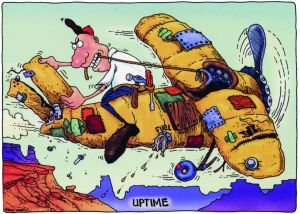How to Build a High Performance Maintenance Team
Mike Stonecipher
Lead a Maintenance Turnaround
A few years ago, this author inherited perhaps the world’s most underperforming, unreliable, unpredictable, unacceptable and all other antonyms that are an antithesis for anything positive, maintenance team. The extreme lack of performance left all sorts of carnage piled up at the front door of the unemployment office. Maintenance managers did not last longer than 18 months before quitting or getting fired. To be fair, it was the result of long-term neglect and a few bad decisions by upper management. Nonetheless, the requirements of the job was to roll up the shirt sleeves, do a deep dive and fix it.
At the bottom of Maslow’s hierarchy of needs are food and shelter. Simply put, SURVIVAL. That was exactly where the company was and its maintenance department was not helping the situation. However, this author’s personal goal went beyond survival. It was to reclaim a higher quality of life by eliminating the late night and weekend calls that started out like, “Boss, you ain’t gonna believe this!” Conditions were so bad that the author personally helped extinguish two fires in one year that could have burned down the facility, which, at the time, did not seem like a bad plan.
Just in case you or someone you know is experiencing a similar undesirable work environment, the author shares this brief recap of the maintenance turnaround plan that was used.

Warning: Leading a maintenance turnaround is not for the faint of heart. It takes guts, vitamins and a lot of prayers, in addition to a good plan.
First Things First:
DELIVER a State of the Union Address before the Maintenance Turnaround
Pull together the facts, no matter how ugly they are, and present them to the entire maintenance team in a clear and succinct message. It is best that all team members hear it at the same time. This is a message that you cannot afford to have delivered secondhand or get misconstrued. Once the bad news is delivered, which is probably old news, begin painting a picture of the future and call it the “target condition.” Demonstrate passion and convey what a critical role the maintenance department plays in the execution of the business strategy, achievement of operational performance targets and safety. Next, highlight some of the initial steps that will be taken to get the turnaround process started. No need to communicate a long, boring comprehensive plan. Just stick to the key areas that will receive a laser focus so the journey and dedication to achieving the target condition is crystal clear.
This meeting is not about searching for agreement or reaching a consensus. It is about setting a new direction and establishing a starting point for the turnaround. It is about encouraging those that want to change, converting those that are on the fence and firing a warning shot to those who are dead set on maintaining status quo. Will there be teamwork, employee feedback and participation? You bet! It is impossible to reach target condition without a fully engaged workforce.
DEVELOP a Code of Conduct and Daily Standard Work
This is the first maintenance team assignment. Pull together a mix of formal leaders and informal leaders. Why informal leaders? Because often they are the ones that others are going to follow. On a flip chart, begin documenting the characteristics of a high performance maintenance team. At this point, nothing is too basic. In fact, most of the items on the list should be fundamental and include such things as: start and stop times, protocol for shift hand off, documenting work performed, providing feedback to operators, behaving in a courteous and professional manner, and so forth. Take the feedback and create two formal documents: a code of conduct and daily standard work. Each document should be no more than one page in length. Once completed, ask the sub-team to present the documents to the team. It is critical that everyone hears the message, understands the documents and signs a training record. Post the documents in very conspicuous places throughout the maintenance shop. It is also a good idea to have some of the maintenance team members report on the new mode of operation at a monthly all employees meeting or at operational team meetings.
Now that expectations are clear, all future group meetings will be conducted with a sense of urgency and in a celebratory manner for each accomplishment achieved, even the small ones that look like baby steps. Long-term success is going to be built by putting points on the scoreboard, not by a single silver bullet. Will there be tough discussions? Yes, but probably with only a small percentage of the group. From this point forward, those discussions will be held in private and on an individual basis. Everyone else will be receiving praise and encouragement.
PURGE the Junk
This is not glamorous work. In fact, it can be extremely nasty. However, the result will make a huge impression, improve efficiency, safety and morale, and generate a cleansing feeling. It is like a new beginning. Don’t be surprised that when you start purging the junk, you end up with over 14 flatbed trailers full of scrap steel and obsolete equipment for the recycler – no kidding!
Start with the red tag process. Expect some pushback because someone will insist that you keep that “one-of-a-kind inoperable 1968 strain gauge that was made by a company that no longer exists.” Target purging the junk in the maintenance department first, then attack all other hidden areas scattered throughout the factory. Tackle the maintenance, repair and operations (MRO) tool crib, red tagging all junk and obsolete parts. Be sure not to forget or overlook cabinets and drawers.
During this process, keep the finance department or controller informed so assets can be properly accounted for. Before hauling everything to the recycler, pull a team of engineers, operators and maintenance technicians together to review the red tag area just to make sure there is nothing expensive, unique and still vital to maintenance and/or operations in the hold area. When completed and the junk is on its way to the recycler, the accomplishment will feel refreshing. Make a point to give the team positive feedback and celebrate! But don’t stop there, because this is only the first step in the 5S process.
CONDUCT a Skills Assessment during the Maintenance Turnaround
This is optional based on the demonstrated strengths and skills of the individuals within the department. But if you suspect that the skills are insufficient, then they probably are insufficient. Do not swing at this assessment alone. Team up with human resources and your local technical or community college. There are several great resources and tools already developed, tested, validated and ready to use. This assessment is the starting point for building a strong, competent team. If you work in a union environment, the skill assessment still can be accomplished by working closely with the union leadership, sharing the vision and getting their buy-in to the plan.
START the Training Process
Once the job requirements have been determined and individual capabilities assessed, provide individual feedback in a confidential manner, along with a prescribed training plan. Again, this is best done through human resources and outside support. Establish a fair and reasonable time frame for completing the prescribed training plan. There will be pushback, but there also will be those who are trailblazers and set the course of action for being the first to complete the training. The good news is that course work is now conveniently available online and lab work can be conducted on-site or possibly at a technical school.
Good training is part of a successful maintenance turnaround.
DEVELOP a Critical Equipment List
Identify the key equipment that can bring operations to a halt. It can be a single piece of equipment that is part of the process in which most of the products manufactured flows through it, or it can be equipment that does not have a backup or alternate process. Do not overlook infrastructure when evaluating critical equipment. If the facility or process is dependent on a boiler, compressor, cooling tower, or electrical substation, then be sure to include those items on the list of critical equipment. A substation that has been ignored or overloaded can be dangerous, create costly repairs and cause significant downtime.
A good approach for dealing with critical equipment is to: 1) have a robust preventive maintenance (PM) plan; 2) inventory critical spare parts; and, 3) have a backup plan for a catastrophic failure. For example, identify and pre-approve a contract manufacturer for temporary outsourcing. Redundant equipment is also something to consider, especially if outsourcing options are unavailable or control of intellectual property is critical.
CONSTRUCT a Capital Plan
Now that the junk is purged and a critical equipment list is constructed, identify the equipment that needs to be placed on an intensive care list. This list is for equipment that is currently on life support. Engineering support or an equipment technical representative from the original equipment manufacturer (OEM) should be able to help evaluate the options (e.g., invest in repairing and upgrading the equipment or purchase new equipment and unplug the life support). The costs and return on investment (ROI) for replacing or upgrading equipment on the intensive care list are the beginning of the capital plan. Depending on the company’s health, a short-term repair may take precedence over replacement until funding can support a long-term solution.
Based on the size of the operation, equipment condition, complexity and advances in technology, the capital plan may be a three- to five-year outlook. This type of planning and detail will help with budgeting and eliminating surprises. There are other options to consider if capital is limited or non-existent, such as vendor financing. This is more common for very expensive equipment, like machining centers, lasers, etc.
HIRE a Reliability Engineer in a Maintenance Turnaround
A reliability engineer is extremely valuable, especially if sophisticated or complex equipment is involved. The ability to evaluate machinery, identify its weaknesses, develop a thorough PM plan and make engineering modifications to improve reliability will break the chains of unpredictable performance and reactionary maintenance. It is not unusual for a good reliability engineer to generate a savings of six to eight times his or her salary in the first year.
TOSS the Spreadsheets and Flash Cards – Go With CMMS
There are many low cost options for a computerized maintenance management system (CMMS). The ability to track and measure performance in real time is critical to achieving the target condition. A CMMS enables the maintenance team to optimize the usage of replacement parts, properly assign resources, plan for performing PMs and evaluate the effectiveness of the work being performed. If your company can afford it, install a wireless system and purchase tablets so entries and pictures can be made at the point of service. This is a big time-saver versus going to a computer terminal and getting in line to make entries.
IMPLEMENT the Right Metrics for a Maintenance Turnaround
It is not unusual to jump right to an overall equipment effectiveness (OEE) metric and wonder why performance is not better. Although OEE is an excellent metric, it is better to start off with basic metrics and master the simple things. For example, understanding equipment downtime and reason codes will provide guidance to root cause evaluation and corrective action. Understanding where resources, both people and parts, are consumed can help with determining if there is a skill deficiency, equipment misuse, design issue, or some other assignable cause. Once these metrics are clearly understood, posted and discussed daily at the equipment, add metrics like mean time between failures (MTBF) and OEE to gain a deeper understanding on how to improve performance. The target condition should be great uptime (i.e., 100 percent) and a strong, favorable ratio of time spent conducting preventive maintenance versus performing reactionary maintenance for unplanned downtime.
DEVELOP a Lean Maintenance Methodology
What applies to operations applies to maintenance. Methodologies, such as 5S, single-minute exchange of dies (SMED), standard work and kanban, all can be exemplified in the maintenance department. For example, with 5S, everything should have a designated place and be in its place. Therefore, if you implement a parking lot for maintenance buggies with clear visuals and signage, it sends a message that everything you do matters and should be done in an organized and efficient manner. This simple idea makes it very easy to determine who is at work and who isn’t. It prevents a traffic jam at shift change and makes it convenient to conduct a 5S inspection. Other simple ideas and techniques include quick disconnects for hydraulic units, standard work for tool maintenance, visuals for total productive maintenance (TPM) plan and a kaizen schedule for targeted areas of improvement. Value stream mapping events can be used for processes like the MRO procurement cycle. If there is a tool crib, implement a kanban system for spare parts and consider vendor-managed inventory (VMI) for small parts like nuts and bolts. Converting to VMI can reduce time spent managing small parts and swap inventory on the balance sheet for cash.
ENGAGE the Operators
You’ve probably said or heard the phrase, “Please treat the equipment like you would your house or car.” Many folks, in fact, do treat the equipment they operate exactly the same way they treat their house or car – very poorly! So change your approach to, “Please treat the equipment in a way that our target condition of being ready to run, clean and well maintained is achieved.” This can be a major cultural change. So the onus is on leadership to work with the operators to establish and achieve the target condition. It can be a challenge and requires a lot of training, auditing and follow-up. The best tools to use are a good TPM plan and 5S check sheets. Eventually during this maintenance turnaround, the behavior will change, new habits will form and the target condition will be achieved on a daily basis. Make it fun! Have a competition and reward the shift or team that does the best job achieving and maintaining target condition.
Maintenance Turnaround SUMMARY
Building a high performance maintenance team is not a three-month undertaking. It is not a part-time initiative or approach. Depending on where the department is on the maturity curve, the age and deterioration of equipment, and the overall health of the business, a maintenance turnaround can be a three- to five-year journey. However, significant improvements are often realized in the first three to six months by being relentless, firm and encouraging.
The author’s company did survive and posted some impressive profits during its third year in the maintenance turnaround. However, perhaps the biggest reward during the maintenance turnaround was the bond and respect the operators and maintenance team developed for each other. It is a behavior that becomes contagious based on a common purpose of making the equipment better today than it was yesterday.

Mike Stonecipher
Mike Stonecipher is a Senior Project Manager for Georgia Tech’s Enterprise Innovation Institute. He specializes in strategic planning, leadership development and managing projects that will enable top-line growth and generate bottom-line results for manufacturers throughout Georgia. Prior to joining Georgia Tech, Mike served 15 years in the automotive industry and has also worked in the energy and sustainability industry.
Related Articles

How to Fix the 70/30 Phenomenon

Zen and the Art of Managing Maintenance

Why do maintenance improvement initiatives fail to deliver? (Hedgehog or Fox?)

Why Maintenance Improvement Efforts Fail

TPM and RCM: Whirled Class

Where Do Maintenance Professionals Come From?




